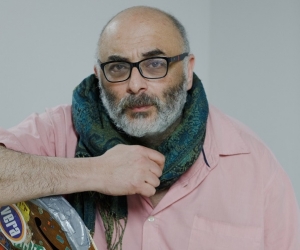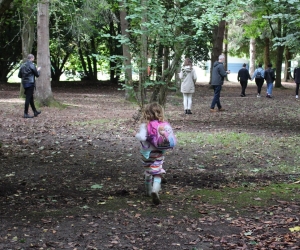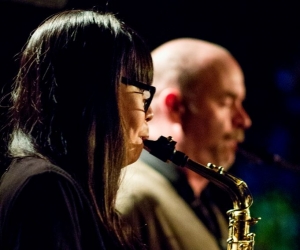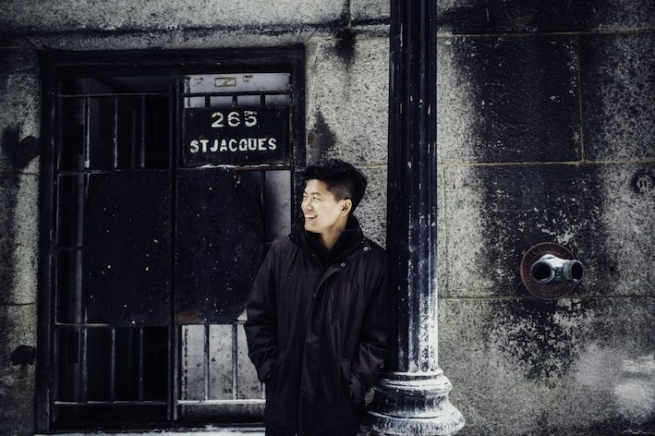
Adjudicating applications for an emerging-composer program is a sort of high-volume evaluation scenario that necessitates a concentrated mode of listening in order to provide fair and sufficiently individualized appraisals. But every so often, you come across a candidate whose music is so immediately arresting that it shatters this hyperfocus and engulfs you. This is precisely what happened to me in 2017, when I first encountered the music of William Kuo. His acute and unsettling sense of instrumental colour conjured all manner of eldritch sonics—the hollow hiss and clank of old pipes, buzzing wings of a large-yet-unseen insect, the perforated whine of flickering fluorescent lights, distant clatter resonating through ventilation. For me, Kuo was easily one of the strongest and most unique candidates. Yet my fellow jury members had different and somewhat uncertain responses. Where I heard an unbridled sonic and sculptural imagination, others struggled to listen through his patinas of noise and foreboding textural decrepitude. His nomination for a Gaudeamus Award the next year may have vindicated my viewpoint, but it also demonstrated the polarizing peculiarity of his work.
Born in 1990, William Kuo moved from Taiwan to the Vancouver area at age nine. During childhood, his primary creative outlet was drawing. Even into his teens he still aspired to a career in architecture. His early musical training followed fairly traditional lines. It wasn’t until he enrolled in McGill University’s Schulich School of Music (where he earned a Bachelor of Music, major in composition) that he encountered anything even resembling his present creative universe. Composer Anthony Tan’s introductory course in electroacoustic music there ruptured Kuo’s fundamental musical worldview. The mere proposition that the abstract landscapes confronting him in class could be considered music at all felt almost absurd. But the shock soon subsided and was replaced with utter fascination. “Somehow, not understanding it really attracted me to it,” he says of his immersion in the acousmatic repertoire. “That planted a seed for my current aesthetic and my preoccupation with sound.”
This preoccupation has led to a number of potent artistic statements and collaborations with leading ensembles such as Asko|Schönberg, Quasar Saxophone Quartet, Ensemble Multilatérale, Nouvelle Ensemble Moderne, and Ensemble InterContemporain. Yet Kuo’s assertive musical language contrasts his naturally restless, circumspect demeanour, producing in him a contradiction—vital creative fuel on one hand, and powerful internal friction on the other. Instead of plunging directly into the uncharted electronic depths, he turned to studying instrumental writing: “I couldn’t yet imagine any sounds in my head, so I knew I needed to spend a lot of time just doing that to hone that craft.” Listening to his early works—such as Scintillant (2012), composed for the Quatuor Bozzini’s Composer’s Kitchen—one would never take him for a late bloomer. Even though he was still an undergrad when it was composed, it radiates an assured, mature, and individual grasp of texture and instrumental sonority.
His graduate studies at Le Conservatoire de musique de Montréal were marked by his trademark self-scrutiny and left him, once again, itching to reinvent himself. By 2014 Kuo’s growing irritation with his habits led him to adopt an external framework for generating rhythm. His system would output numbers that regulated the global density of sound-events. Kuo would painstakingly translate the ensuing data into a rhythmic blueprint, which he would then populate with sonic material.
This reinvention was further motivated by his attending the Darmstadt International Summer Courses, which he calls a “frustrating, but refreshing and transformative” experience. He discovered a totally unfamiliar mode of listening through the unique senses of temporality, space, and dynamics of composers like Marc André, Peter Ablinger, and Morton Feldman. Xenakis’ thinking pertaining to onset distribution also informed Kuo’s new approach, the implementation of which feels organic and even volatile, rather than betraying its own numerical rigidity.
Kuo’s 2014 work brim, veer, a trio for two percussionists and bass trombone that was reprised in September 2018 at Gaudeamus by Ensemble Klang, signalled the beginning of this new aesthetic period. Its coarse yet delicate environments hover inexplicably with sharp, sudden attacks puncturing the hush like sudden flicks of a switchblade. The composition uses as few conventional percussion instruments as it does standard techniques. As the trombone emits frayed wind of various consistencies, the two percussionists activate the strings of a dulcimer and piano with bows and friction-producing implements, occasionally striking the instruments’ bodies for tuned, resonant bursts. In one particularly time-suspending passage, one of the percussionists gently caresses a hung sheet of tinfoil.
In 2016 Kuo began to grow weary of the labour-intensive methodology he developed for generating rhythm. His newer pieces were becoming riddled with detours from—and outright exceptions to—the rules. He therefore decided to reacquaint himself with the wide-eyed impulse that drove him toward composing in the first place. “Before meeting up with the ensemble or performer, I try things myself,” explains Kuo, who rents or buys instruments in order to create the direct and instinctual relationship that has become so fundamental to his work. He records these preliminary experiments as both audio and video—the latter providing visual proof that the unconventional techniques, preparations, and modifications he comes up with are indeed possible for performers to execute. The videos are also the basis for directed improvisation sessions that Kuo initiates with his collaborators at their first meetings; and since the players make fruitful discoveries or suggestions along the way, Kuo also records these sessions.
Just as the videos help performers recall and internalize Kuo’s arcane technical demands, the audio tracks of these sessions allow Kuo to build scale models of his pieces in recording software. Much of his recent work employs a mixture of amplified acoustic instruments as well as varying degrees of electronic sound, from live processing to fully synthetic elements. Having everything in the same domain from the outset allows him to hear these blends with greater clarity. Usually, a few of these sessions will yield his core sound palette for a given work. He’ll begin composing by zeroing in on one particular element, extemporizing upon it, and superimposing other sounds until it’s been shaped into a self-contained arc. As sections such as these accumulate, the total structure of the piece begins to reveal itself slowly. Kuo eventually arrives at a fixed sequence and then turns his attention toward formal balance, expanding or truncating the various segments.
Working this way ensures that he’s able to maintain a tactile, visceral, and intuitive relationship with his materials at every stage of the piece’s gestation. “The way I compose is in the spirit of improvisation,” says Kuo. “You open up one path initially and then that path opens you up to some more.”
It is only once this collage is fully realized that Kuo sets about notating the instrumental aspects. This stage isn’t so much a matter of transcription as it is a process of ushering the piece out of the virtual realm and into a living performative reality. Considerable amounts of additional shading, coloration, and detail are added on the page with the intention of honouring the sounds’ full dimensionality. “The tough part becomes really limiting yourself with material. Everyone approaches the same thing differently; everyone has a different perspective. You realize there’s an endless amount of possibilities.
“I think that’s probably my biggest struggle,” he adds. “I think much of my music has too much material—like I’m too greedy: I want to use everything I found in the same piece.”
In his quest for a more economical use of material, Kuo has found fresh perspectives through revisiting and recombining elements from his growing audiovisual archive. The Hand Holds No Weapon (2018), for instance, examines the physical sensations of sub-bass frequencies, while returning to earlier explorations that extended the saxophone with PVC tubing.
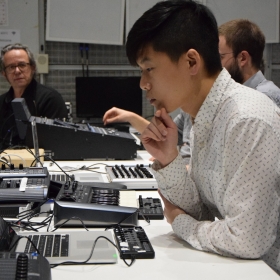
One of Kuo’s most recent works, fascia—a solo clarinet and electronics piece for Juliette Adam at IRCAM’s Cursus program—has, unsurprisingly, opened new avenues of curiosity and introspection. Adam is a skilled improviser, and the work derives quite directly from her instinctive vocabulary. She also finds it more natural to memorize the work than to read it, which has prompted Kuo to question how he habitually communicates the contents of his pieces to performers.
Lately he’s been working to access the candour and power of improvisation while harnessing the natural theatrical import of the concert environment. “When something big happens in improvised music it seems so much more surprising, so much more spontaneous than in written music,” he offers. “Maybe it also has to do with the visual aspect, where the performer isn’t looking at the score, they’re just looking at their instrument. It’s very internal. They’re facing themselves.” He is currently considering more graphical representations or even dispensing with scores altogether, in favour of verbal cues in headphones, with the goal of coaxing a more impulsive energy from the players.
On the cusp of what might be another dramatic change, William Kuo regards his earlier output with a degree of uncertainty, despite the fact that these pieces have justifiably cemented his reputation as a singular, innovative composer. Right now, he’s focused on slowing his compositional output, which allows him to invest in stronger and more profound collaborative partnerships. “Intuition only takes you so far,” he says. “I’m very open to new knowledge or approaches I haven’t considered. I’m not stubborn in that way.”
Top photo of William Kuo by Steve Gerrard. Bottom photo of KuoIRCAM's Cursus program in 2019 by Mikhail Malt.
